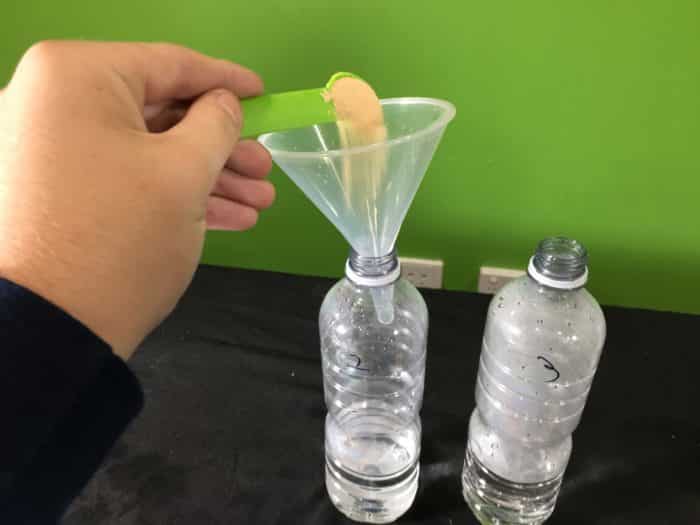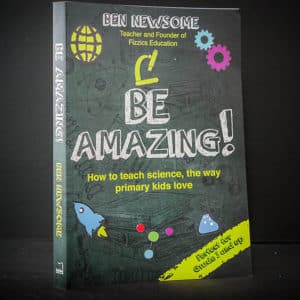You Will Need:
- 4 packets of dry yeast
- 4 water bottles, chilled in the fridge (we use Thank You Water, a social enterprise that works to get
clean water & sanitation to people in need) - 4 balloons
- 1 funnel.
- 1 spoon.
- 1 large jug.
- 4 measuring cups.
- 4 thermometers (one will do if you don’t have a class set).
- Sugar.
- Access to boiling water plus adult supervision.
- 1 stopwatch.
- A pen to mark the water temperature on each water bottle during the experiment.
- A shelf to leave the science experiment to run.
- A notebook for your observations.


Pour out the 4 chilled water bottles into the large jug and discard the rest of the water (maybe water your school garden!)
Carefully measure out the water into the four measuring cups as per the measurements below;
Cup 1 – 200mL of chilled water
Cup 2 – 150mL of chilled water
Cup 3 – 100mL of chilled water
Cup 4 – 50mL of chilled water
Use the thermometers to take a measurement of the water temperature in each cup (write this in your notebook).
With an adult, boil a jug of water and then top up cups 2, 3 and 4 so that they too have 200mL of water as per cup 1. You will be testing the effect of temperature on the growth of yeast by measuring how much gas is released by the yeast under 4 different temperature conditions (variable testing).

Go further – buy 4 x student activity sheets as extension worksheets.
This student science booklet has been created by experienced science educators from the Fizzics Education team.
Use these student worksheets as blackline masters for your science class!

School science visits since 2004!
– Curriculum-linked & award-winning incursions.
– Over 40 primary & high school programs to choose from.
– Designed by experienced educators.
– Over 2 million students reached.
– Face to face incursions & online programs available.
– Early learning centre visits too!
What is going on?
Your experiment was testing the effect of water temperature on the growth of yeast. Yeast are egg-shaped microscopic cells of fungi that are dormant whilst kept in dry and cool conditions. However, yeast will rapidly divide once exposed to water and sugar in ideal temperatures. In the right temperature, yeast cells will change the sugar into glucose by using the water plus as an enzyme catalyst (invertase). Once the yeast has converted the sugar to glucose fermentation can then occur to produce carbon dioxide and ethanol as per the equation below;
Glucose ⟶ Ethanol + Carbon dioxide
which can be written as…
C6H12O6(aq) ⟶ 2C2H5OH(aq) + 2CO2(g)
In your experiment, you were trapping the carbon dioxide released during the fermentation process. The more active the yeast, the more carbon dioxide the yeast produced! In your experiment, the different water temperatures will have produced different results as bottles may have been too hot for the yeast to survive whereas the other bottles may have been too cold. By introducing a variable to test in your experiment, you’re doing real science! The following list of temperatures is worth keeping in mind when assessing your results:
- 55° C – 60° C
Yeast cells die (also known as the thermal death point). - 41° C – 46° C
Ideal temperature of water for dry yeast being reconstituted with water and sugar. - 4° C
The temperature of a fridge – yeast will be too cold to work properly.
Yeast is used to make bread rise and to ferment beer. There are many different species of yeast, but the one most commonly used in cooking and baking is called Saccharomyces cerevisiae, which is also known as brewer’s yeast.

Yeast we used for our science experiment.
Yeast can break down many types of simple carbohydrates (monosaccharides) however they cannot break down complex carbohydrates such as starch. This means that extra enzymes are needed to break down starch into sugars that the yeast can use, for example during beer production we use enzymes from germinating barley to do this.
Variables to test
- Try different concentrations of vinegar as the growth medium. Can the yeast handle some acidity?
- Vary the amount of sugar used.
- Does the volume of water make a difference?
Classroom activity sheets for this experiment
Create, reflect & extend!
From colour changes to slimy science, we’ve got your kitchen chemistry & biological science covered!
Get in touch with FizzicsEd to find out how we can work with your class.
Digital Microscopy
Years 3 to 6
Maximum 30 students
School workshop (NSW & VIC)
60 minutes
STEM Full Day Accelerator - Primary
Designed from real classroom experiences, this modular day helps you create consistently effective science learning that directly address the new curriculum with easily accessible and cost-effective materials.

































What is the amount of water you would like me to put?
Hi!
Here’s the detail’s that you need;
> Cup 1 – 200mL of chilled water
> Cup 2 – 150mL of chilled water
> Cup 3 – 100mL of chilled water
> Cup 4 – 50mL of chilled water
Use the thermometers to take a measurement of the water temperature in each cup (write this in your notebook).
With an adult, boil a jug of water and then top up cups 2, 3 and 4 so that they too have 200mL of water as per cup 1. You will be testing the effect of temperature on the growth of yeast by measuring how much gas is released by the yeast under 4 different temperature conditions.
Would this experiment still work if instead i tested how different types of sugars affect the amount of fermentation by yeast. Would i still get different sized balloons in my result.
We’d love it if you try this and let us know!
With any experiment you just have to change one thing and then measure the result.
So, changing the types of sugars is a completely valid investigation.
Good luck!